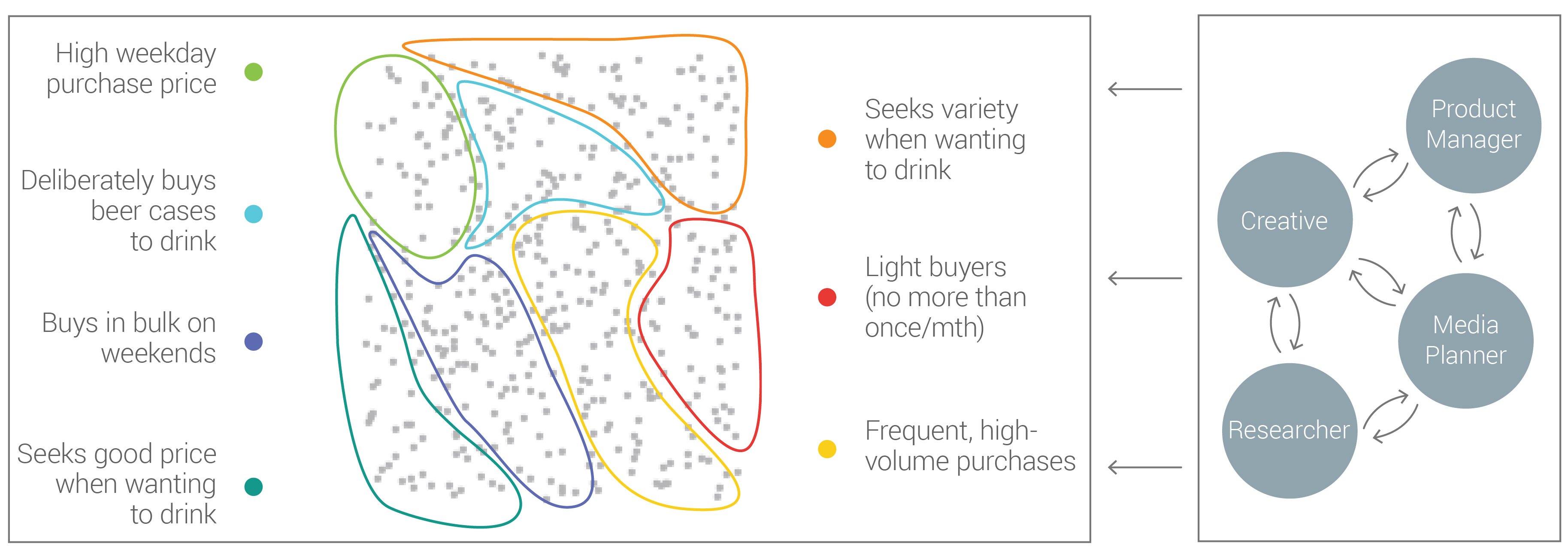An all too common scenario: A product manager, creator, media planner, and research analyst create marketing materials to address one specific group. But then they end up targeting a completely different group. How do we avoid this to make targeting consistent across the different functions of a business?
When targeting goals are out of sync
The term “targeting” can carry different meanings depending on business function. To a product manager, targeting may refer to customers and their purchasing habits; to an advertising strategist, targeting may refer to new consumers; and to a media planner, targeting may include media audiences such as men and women in their 20s to 30s. It’s easy to see how marketing materials developed for a specific audience might end up targeting a different group entirely.
This discrepancy is rooted in the differing parameters used by varying business functions within different teams. For example, net sales are the objective for product managers, while audience reach is the objective for media planners. In other words, when business units start to conduct surveys that only satisfy their own requirements, the company will fail to operate as a whole and the result will be a configuration of substandard targets. How do we make targeting more consistent so marketing strategies can become more effective?
Lessons from the alcoholic beverage market
We must first ask what sort of data is needed for targeting to be more consistent. In product development, the data should give you a broad view of the entire market environment. In planning, it should separate the buyers from the non-buyers of a product and include where and how often the buyers make purchases. In media investments, it’s important to know what kind of media consumers come in contact with and when. Since it’s difficult to obtain accurate data on buying and media contacts through questionnaires, it’s preferable to use behavior log data.
Using the Single Source Panel,1 we conducted an experiment on the alcoholic beverage market. This market was selected not only because it’s one of the largest in Japan, but its consumer set has strong preferences and a high buying frequency, making it suitable for analysis in terms of both data volume and dispersion.
Independent variables, such as price, quantity, and number of purchases for beer, shochu, and the rest of the alcoholic beverage market, were set based solely on actual buying data from individual survey panel respondents. Cluster analysis was performed to categorize consumers based on their purchasing habits, and each of the seven clusters was named according to its buying traits (for example, “seeks variety when wanting to drink” or “buys in bulk on weekends”). The clusters were then cross-referenced with questionnaire data on lifestyle and buying values to gather a more detailed look at their alcohol purchase behavior.
Segments of alcoholic beverage purchasers based on cluster analysis

Results of the survey showed that the “seeks variety when wanting to drink” cluster was especially selective about food and was susceptible to information regarding new products and cuisine. The group had a strong tendency to take in information about new products and try them out. While the “buys in bulk on weekends” cluster had a slightly higher household income (regardless of age), the group was uncertain about the future and was careful about spending money. Nevertheless, the segment responded positively to hot-selling items.
A study of these seven clusters revealed that the “frequent, high-volume purchases” cluster and the “seeks variety when wanting to drink” cluster characterized less than 20% of all alcoholic beverage buyers, yet together they accounted for half the total purchase volume by alcoholic beverage buyers. On the other hand, while many of those in the “light buyers” cluster responded that they “do not buy alcohol” in questionnaires, results revealed that they do indeed purchase alcoholic beverages, even if only infrequently.
Sample marketing initiatives to target the “seeks variety when wanting to drink” cluster
So how did a product manager, an ad creator, a media planner, and a research analyst successfully use this data to plan their marketing strategies?
Product manager
The product manager focused on the group’s selectivity toward food and propensity to make large purchases of wine. Consequently, the product manager developed a 250-ml one-time serving can with the concept “wine for the home that goes with Japanese cuisine” and “wine for the home that goes with pasta.” The group’s inclination to try new tastes inspired the product manager to change the wine varietals and regions every month to encourage even more purchases.
Ad creator
Based on the cluster’s sensitivity to information about food, the ad creator conceptualized a reality show inviting the group to join celebrities in trying food products that were trending or becoming popular on the internet. Various proposals are now being discussed to turn the idea into a series and execute the plan over the long term.
Media planner
The media planner focused on the fact that the group spent equal amounts of time watching TV as it did using computers and mobile devices. Consequently, the media planner decided to create greater online exposure while maintaining their relationship with retail stores (which usually pay attention to the GRP of new products). The media planner chose to keep ads on TV limited to news and informational programming (in line with the target’s interests) and used strategies such as the custom affinity category2 to optimize digital ads.
Research analyst
The research analyst conducted research based on the different psychographic clusters rather than the traditional demographic segmentation, ad recall, and brand awareness to ask questions like:
- What percentage of the total audience included the target cluster?
- Did brand awareness and interest in the brand increase among the target cluster?
The researcher formulated a research plan that assigned assessment points based on three key characteristics:
- Percentage of ads that reached the target cluster
- Percentage of all people reached by the ads that belonged to the target cluster
- Individual attitude change as a result of the ad
Using a single database as the starting point, the team achieved consistency in the market and customer analyses, genuine portrayals of the target, more accurate product and creative idea planning, and streamlined evaluations of media plans and advertising investment. This is an example of marketing that is truly inspired by consumer behavior, the essence of targeting.
Each team used the same target audience definitions for more consistent results

Leveraging digital methods in the overall marketing plan
Digital marketing used to be defined as the analysis of traffic to and the activities that occurred within a website as well as the running of ads targeted at the website’s audience. However, taking into account this new approach, the definition can be applied to circumstances beyond digital, such as product development, creative ideation, and cross-media planning, allowing for a more holistic and consistent approach to marketing plans and execution.
The research described here reinforces the idea that targeting goals linked to behavioral data can transcend digital marketing and be consistent across the entire discipline.
Today, marketers are challenged to meet high returns on their marketing spend so they’re taking great strides to develop new ways of achieving these returns. Similar tactics include this consistent target cluster-based marketing model, which is useful not only for the effective planning of marketing dollars, but also to maximize impact among target audiences.
This article was originally published on June 12, 2015 in Japanese.







